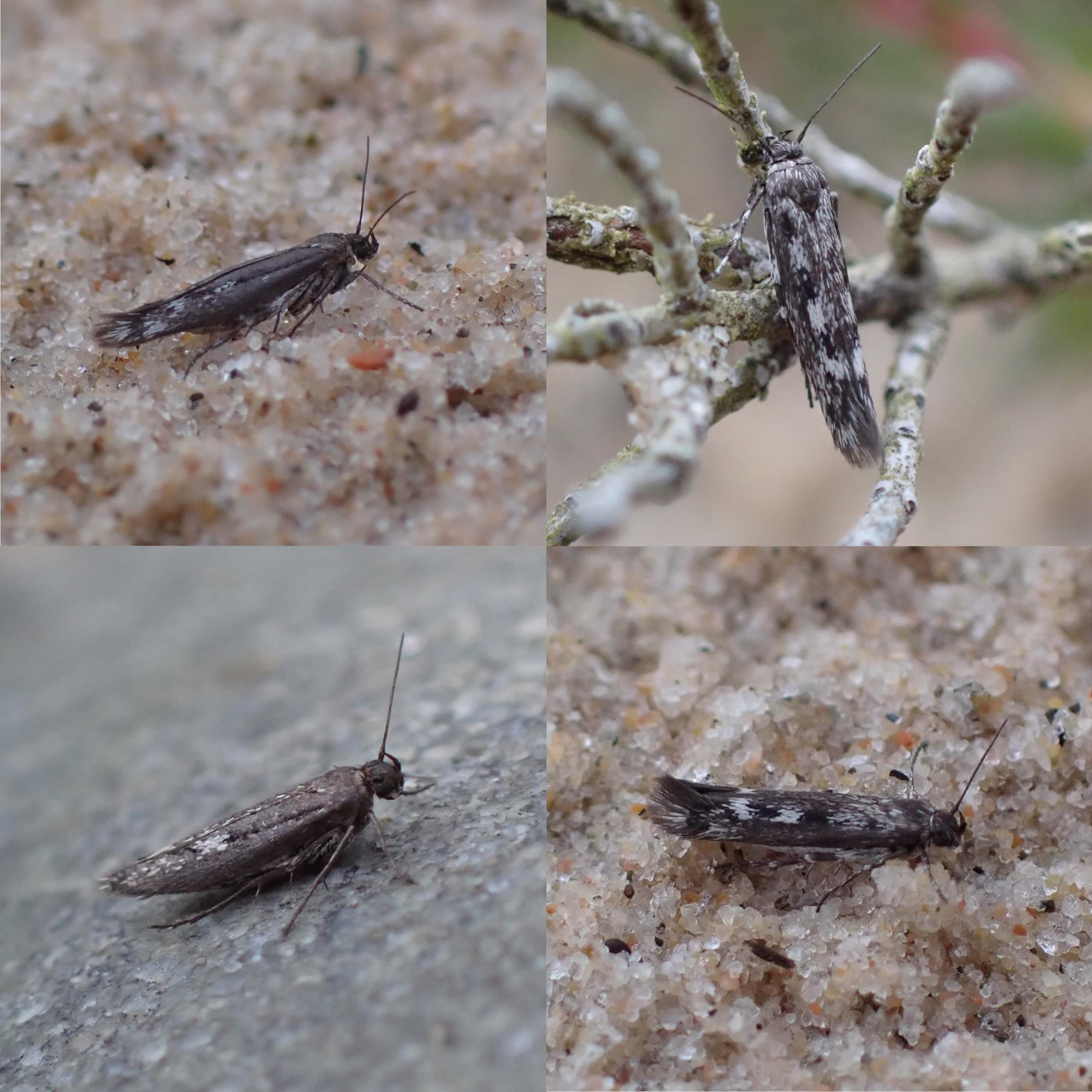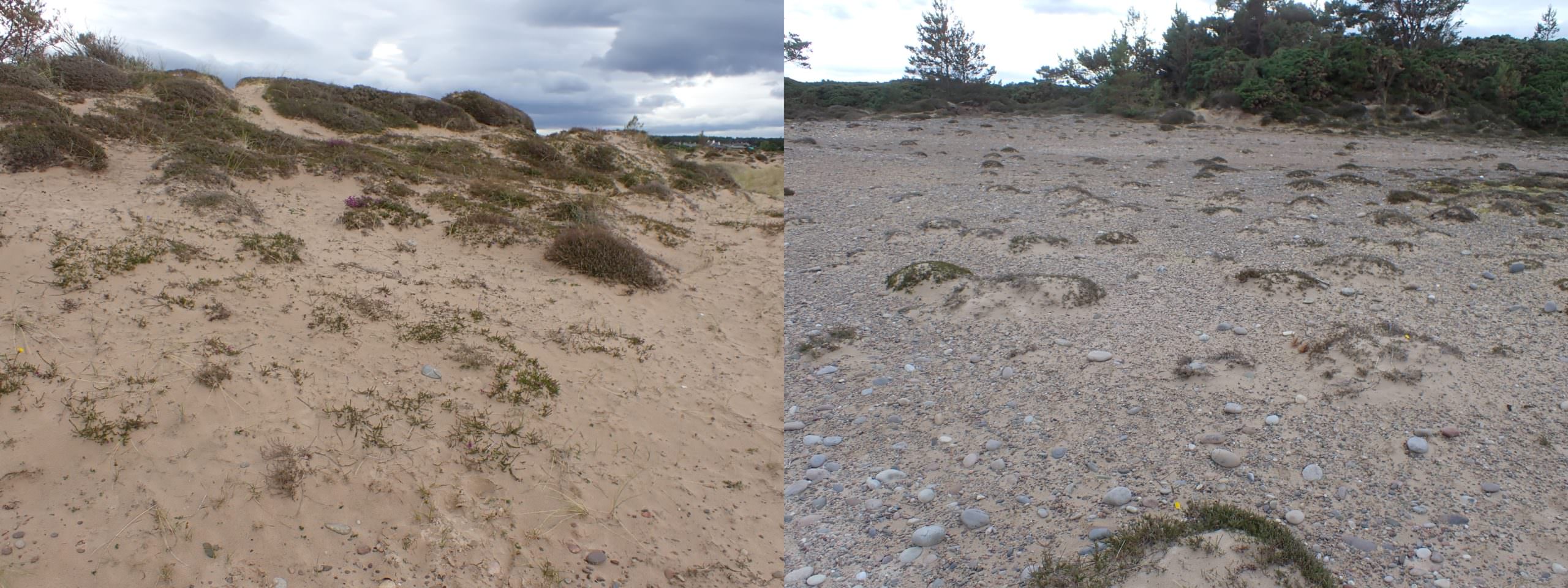Findhorn dunes are widely recognised for their unique habitat and specialist biodiversity, particularly their lichen assemblages. However, what is less widely known is the importance of the dunes for moths. Many scarce duneland specialist species make Findhorn their home, such as the Lyme Grass moth Longalatedes elymi, the Coast Dart Euxoa cursoria, or the enigmatic and beautiful Portland Moth Actebia praecox. However, there is one species for which Findhorn is far more important.
Scythris empetrella is a small (4-5mm long) moth in the Scythrididae family. At first glance it appears unremarkable, and may not be recognised as a moth due to its lack of willingness to fly – the adults prefer to make short jumping flights off of the sand almost akin to the motion of a sandhopper. However, on closer inspection the moth reveals itself to be an attractive charcoal grey with a variable degree of whitish irroration (figure 1).
Figure 1 – Adults of Scythris empetrella from Findhorn Dunes, 28th June 2022. This figure gives a sense of variation in the markings of the adult moths. Note images not to scale.

In Scotland, Scythris empetrella is only found at two sites: Findhorn Dunes, and Cuthill Links on the Dornoch Firth. The moth is abundant at Findhorn but has only been found once at Cuthill, making Findhorn the most important site for this species in Scotland. Outside of Scotland the moth is found at a handful of sites in the New Forest and on the Dorset heaths in England, and globally is confined to sand dunes and similarly sandy habitats along the coasts of the North and Baltic Seas.
What makes Findhorn so special for this species is unknown, but it might have something to do with the feeding habits of its caterpillar. The caterpillar eats Crowberry (Empetrum nigrum) and Heathers (Erica and Calluna), feeding from within a sand-covered tube of silk which extends from within the sand up to the green leaves of its foodplant. This tube no doubt conceals the caterpillar from predators, but also probably acts as a conduit along which the caterpillar can move at great speed backwards or forwards to escape danger.
Figure 2 – Scythris empetrella habitat, Findhorn Dunes 28th June 2022. The left-hand image shows the site where most adults were found, amongst loose wind-blown sand and heather. The right-hand image shows another site where I found adults, but never in such densities as observed at the previous site.

At Findhorn the adult moths are most abundant in parts of the dunes where green heather stems poke through loose, wind-blown sand (figure 2, left). One can also find them further back from the coastline on wind-sculpted heather hummocks (figure 2, right) but in much lower densities. I would speculate that the swamping of heather and crowberry stems by wind-blown sand allows the caterpillar to access green growth otherwise inaccessible when the plants grow high above the sand. Findhorn is relatively unique amongst the Moray dune systems for having good quantities of heather and mobile sand, which might explain the dunes’ importance for this species.
That said, the moth is easily overlooked and it is very plausible that it may be lurking in other sandy habitats along the Moray Firth. I have failed to find it on the Culbin Bar, but one good place to search for it may be in open parts of Culbin forest where heather grows on loose sand. If anyone spots the moth, or sandy tubes on the heather anywhere along the Moray Firth this summer, I’d ask them to please email me at [email protected] with a date on which the tubes or moth were seen, a six-figure grid reference, and a photograph.
I would like to thank Jonathan Caddy for the invitation to write a piece on this moth, and Fay Wilkinson for providing details on the Cuthill record for this species.
James Hammond
Department of Biology, University of Oxford. The John Krebs Field Station, Wytham, Oxford OX2 8QJ
Email: [email protected]
About the Author:
James grew up in the Findhorn area and attended the Drumduan Steiner School for a time before his present work as a biologist based at the University of Oxford. At present he is volunteering for the Darwin Tree of Life (DToL) Project, which aims to sequence the genome of every eukaryotic organism in the British Isles. His role involves collecting and identifying moth specimens, and then passing them on to the sequencing team who generate the data. The project is non-commercial, and all data is publicly available.

















Findhorn’s special moth
Findhorn dunes are widely recognised for their unique habitat and specialist biodiversity, particularly their lichen assemblages. However, what is less widely known is the importance of the dunes for moths. Many scarce duneland specialist species make Findhorn their home, such as the Lyme Grass moth Longalatedes elymi, the Coast Dart Euxoa cursoria, or the enigmatic and beautiful Portland Moth Actebia praecox. However, there is one species for which Findhorn is far more important.
Scythris empetrella is a small (4-5mm long) moth in the Scythrididae family. At first glance it appears unremarkable, and may not be recognised as a moth due to its lack of willingness to fly – the adults prefer to make short jumping flights off of the sand almost akin to the motion of a sandhopper. However, on closer inspection the moth reveals itself to be an attractive charcoal grey with a variable degree of whitish irroration (figure 1).
Figure 1 – Adults of Scythris empetrella from Findhorn Dunes, 28th June 2022. This figure gives a sense of variation in the markings of the adult moths. Note images not to scale.
In Scotland, Scythris empetrella is only found at two sites: Findhorn Dunes, and Cuthill Links on the Dornoch Firth. The moth is abundant at Findhorn but has only been found once at Cuthill, making Findhorn the most important site for this species in Scotland. Outside of Scotland the moth is found at a handful of sites in the New Forest and on the Dorset heaths in England, and globally is confined to sand dunes and similarly sandy habitats along the coasts of the North and Baltic Seas.
What makes Findhorn so special for this species is unknown, but it might have something to do with the feeding habits of its caterpillar. The caterpillar eats Crowberry (Empetrum nigrum) and Heathers (Erica and Calluna), feeding from within a sand-covered tube of silk which extends from within the sand up to the green leaves of its foodplant. This tube no doubt conceals the caterpillar from predators, but also probably acts as a conduit along which the caterpillar can move at great speed backwards or forwards to escape danger.
Figure 2 – Scythris empetrella habitat, Findhorn Dunes 28th June 2022. The left-hand image shows the site where most adults were found, amongst loose wind-blown sand and heather. The right-hand image shows another site where I found adults, but never in such densities as observed at the previous site.
At Findhorn the adult moths are most abundant in parts of the dunes where green heather stems poke through loose, wind-blown sand (figure 2, left). One can also find them further back from the coastline on wind-sculpted heather hummocks (figure 2, right) but in much lower densities. I would speculate that the swamping of heather and crowberry stems by wind-blown sand allows the caterpillar to access green growth otherwise inaccessible when the plants grow high above the sand. Findhorn is relatively unique amongst the Moray dune systems for having good quantities of heather and mobile sand, which might explain the dunes’ importance for this species.
That said, the moth is easily overlooked and it is very plausible that it may be lurking in other sandy habitats along the Moray Firth. I have failed to find it on the Culbin Bar, but one good place to search for it may be in open parts of Culbin forest where heather grows on loose sand. If anyone spots the moth, or sandy tubes on the heather anywhere along the Moray Firth this summer, I’d ask them to please email me at [email protected] with a date on which the tubes or moth were seen, a six-figure grid reference, and a photograph.
I would like to thank Jonathan Caddy for the invitation to write a piece on this moth, and Fay Wilkinson for providing details on the Cuthill record for this species.
James Hammond
Department of Biology, University of Oxford. The John Krebs Field Station, Wytham, Oxford OX2 8QJ
Email: [email protected]
About the Author:
James grew up in the Findhorn area and attended the Drumduan Steiner School for a time before his present work as a biologist based at the University of Oxford. At present he is volunteering for the Darwin Tree of Life (DToL) Project, which aims to sequence the genome of every eukaryotic organism in the British Isles. His role involves collecting and identifying moth specimens, and then passing them on to the sequencing team who generate the data. The project is non-commercial, and all data is publicly available.